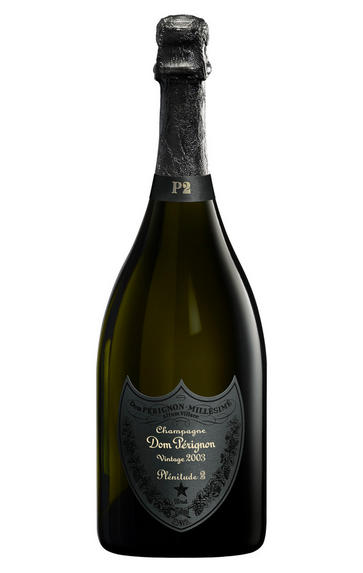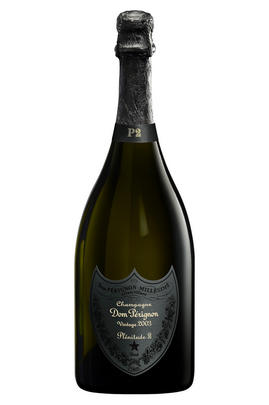
2004 Champagne Dom Pérignon, P2, Brut

Critics reviews
The 2004 Dom Pérignon P2 is precise and wonderfully refined, just like the first release. There’s a hint of reduction from extended time on the cork as well as a feeling of effusiveness that is so appealing. Readers will find a super-classic DP. Dried flowers, brioche, apricot preserves, sage, mint and chamomile are seamless in the glass. The 2004 can be enjoyed now or cellared for another decade plus. Some editions of the P2 series have been pretty austere in the early going; the 2004 is not among them.
Antonio Galloni, Vinous.com (November 2022)
The heatwave year of 2003 was exceptional so the vines didn't have as much energy as usual to devote to grapes rather than wood. So with the harmonious climate of 2004 the vines gave back all the energy to the grapes, which resulted in a good quantity, very good quality and good maturity. 'These sort of years are very rare in Champagne but 1969 and 1970 were similar', according to chef de cave Vincent Chaperon (whose first Dom Pérignon, with Richard Geoffroy, was 2005). (1970 was the time Champagne produced 10,000 kg/ha.) The initial release was 'super-toasty on the nose'. Chaperon wants to firm up the wine in its P2 instance. Disgorged October 21. Dosage <5 g/l. Chaperon is currently experimenting further with dosage. To be launched in October 2022.
Very deep straw. Lime syrup on the nose followed up with a savoury note. Then on the palate it’s very Dom P with that winning creamy lemon-sherbet character on the palate. Big and round and yet with a flirtatious kick on the end. Long with some chewiness. A serious wine that's very easy to like.
Drink now to 2028
Jancis Robinson, JancisRobinson.com (June 2022)
The 2004 Dom Pérignon P2 is drinking beautifully on release, wafting from the glass with aromas of sweet orchard fruit, fresh peach, pastry cream, buttered toast and cotton candy that display a less reductive profile than the original disgorgement. Medium to full-bodied, pillowy and charming, with an ample, enveloping core of fruit, succulent acids and a pretty pinpoint mousse, it concludes with a long, sapid finish. Forward and giving, there's no obvious reason to defer gratification.
William Kelley, Wine Advocate (August 2022)
A solid Champagne with sliced peaches and apples with loads of phenolics and intensity. Full and tightened down. But remains fresh and focused. Big wine. Best with food. Drink or hold.
James Suckling, JamesSuckling.com (August 2023)
P2 is the acronym for the Plénitude 2 series, Dom Pérignon’s second life. It indicates that bottles are kept by the house to let them age on the lees and to obtain different expressions of the same wine throughout its life, letting time work its magic and thus acquiring additional complexity. This year, Dom Pérignon’s cellar master, Vincent Chaperon, decided to release the 2004 vintage. ‘2004 was a contrast to 2003,’ he said. After rain in January, the spring was hot and sunny, like the beginning of summer. But the summer was wet, with 50% more rain than in an average year. Despite this, the health of the grapes was stable and the crop was abundant. ‘This is quite a perfect vintage,’ he added. The bouquet impresses with its finesse and elegance, its delicate aromas of pastry, orchard fruit, nuts, and lemon oil, and both iodine and chalky hints with air. The palate is medium- to full-bodied, very charming, with a sappy texture, racy acids, and a long and lingering finish. This is a very harmonious and rather chalky Dom Pérignon, which must be approached in its singularity. Time is a real asset here. Dosage: 5g/L.
Drink now to 2040
Yohan Castaing, Decanter (August 2022)
About this WINE

Dom Perignon
Dom Pérignon was the 17th century Benedictine monk who has gone down in history as the person who "invented" Champagne. His name was originally registered by Eugène Mercier. He sold the brand name to Moët & Chandon, which used it as the name for its prestige cuvée, which was first released in 1937.
A rigorous selection process in both the vineyard and winery ensures that only the best grapes go into Dom Pérignon champagne. Chardonnay and Pinot Noir are used in roughly equal proportions without one variety dominating the other.
In its youth, Dom Pérignon shows incredibly smooth, creamy fruit with perfect balance and weight. As it ages, it takes on wonderfully toasty aromas and a finesse equalled by very few of the other Grandes Marques.
Since 2014 Dom Pérignon has no longer been using the term oenothèque for its late-release Champagnes, but the word Plenitude. This style represents Dom Pérignon champagne that is left in contact with its lees and does not evolve in a linear fashion, but ages in a series of stages, producing “windows of opportunity, or plenitudes” when the Champagne can be disgorged and released to bring consumers a different expression of the same vintage.
There are three plenitudes in the life of a given vintage: the first plenitude spans between seven to eight years after the vintage, which is when Dom Pérignon Vintage is released, while the second one arrives between 12 and 15 years – which was previously the first oenothèque release, but from now will be branded as P2. The third window comes after around 30 years, when the Champagne has spent more than 20 years on its lees, which will now be termed as P3.

Brut Champagne
Brut denotes a dry style of Champagne (less than 15 grams per litre). Most Champagne is non-vintage, produced from a blend from different years. The non-vintage blend is always based predominately on wines made from the current harvest, enriched with aged wines (their proportion and age varies by brand) from earlier harvests, which impart an additional level of complexity to the end wine. Champagnes from a single vintage are labelled with the year reference and with the description Millésimé.
Non-vintage Champagnes can improve with short-term ageing (typically two to three years), while vintages can develop over much longer periods (five to 30 years). The most exquisite and often top-priced expression of a house’s style is referred to as Prestige Cuvée. Famous examples include Louis Roederer's Cristal, Moët & Chandon's Dom Pérignon, and Pol Roger's Cuvée Sir Winston Churchill.
Recommended Producers : Krug, Billecart Salmon, Pol Roger, Bollinger, Salon, Gosset, Pierre Péters, Ruinart

Champagne blend
Which grapes are included in the blend, and their proportion, is one of the key factors determining the style of most Champagnes. Three grapes are used - Pinot Noir, Chardonnay and Pinot Meunier.
26% of vineyards in Champagne are planted with Chardonnay and it performs best on the Côtes des Blancs and on the chalk slopes south of Epernay. It is relatively simple to grow, although it buds early and thus is susceptible to spring frosts. It produces lighter, fresher wines than those from Burgundy and gives finesse, fruit and elegance to the final blend. It is the sole grape in Blancs de Blancs, which are some of the richest long-lived Champagnes produced.
Pinot Noir accounts for nearly 40% of the plantings in Champagne and lies at the heart of most blends - it gives Champagne its body, structure, strength and grip. It is planted across Champagne and particularly so in the southern Aube district.
The final component is Pinot Meunier and this constitutes nearly 35% of the plantings. Its durability and resistance to spring frosts make the Marne Valley, a notorious frost pocket, its natural home. It ripens well in poor years and produces a soft, fruity style of wine that is ideal for blending with the more assertive flavours of Pinot Noir. Producers allege that Pinot Meunier lacks ageing potential, but this does not deter Krug from including around 15% of it in their final blends.


Buying options
Add to wishlist
Description
The 2004 Dom Pérignon P2 is precise and wonderfully refined, just like the first release. There’s a hint of reduction from extended time on the cork as well as a feeling of effusiveness that is so appealing. Readers will find a super-classic DP. Dried flowers, brioche, apricot preserves, sage, mint and chamomile are seamless in the glass. The 2004 can be enjoyed now or cellared for another decade plus. Some editions of the P2 series have been pretty austere in the early going; the 2004 is not among them.
Antonio Galloni, Vinous.com (November 2022)
wine at a glance
Delivery and quality guarantee